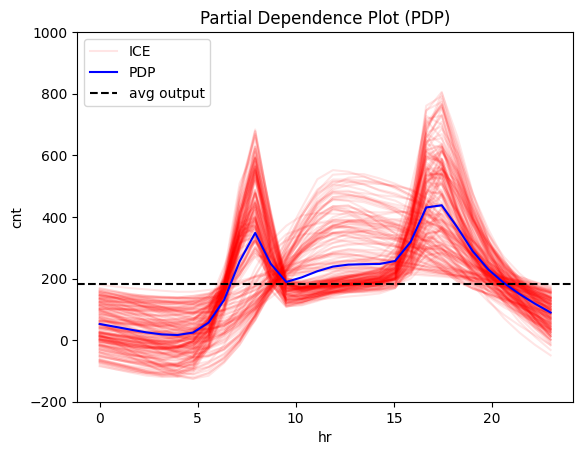An eXplainable AI package for tabular data.
Project description
Effector
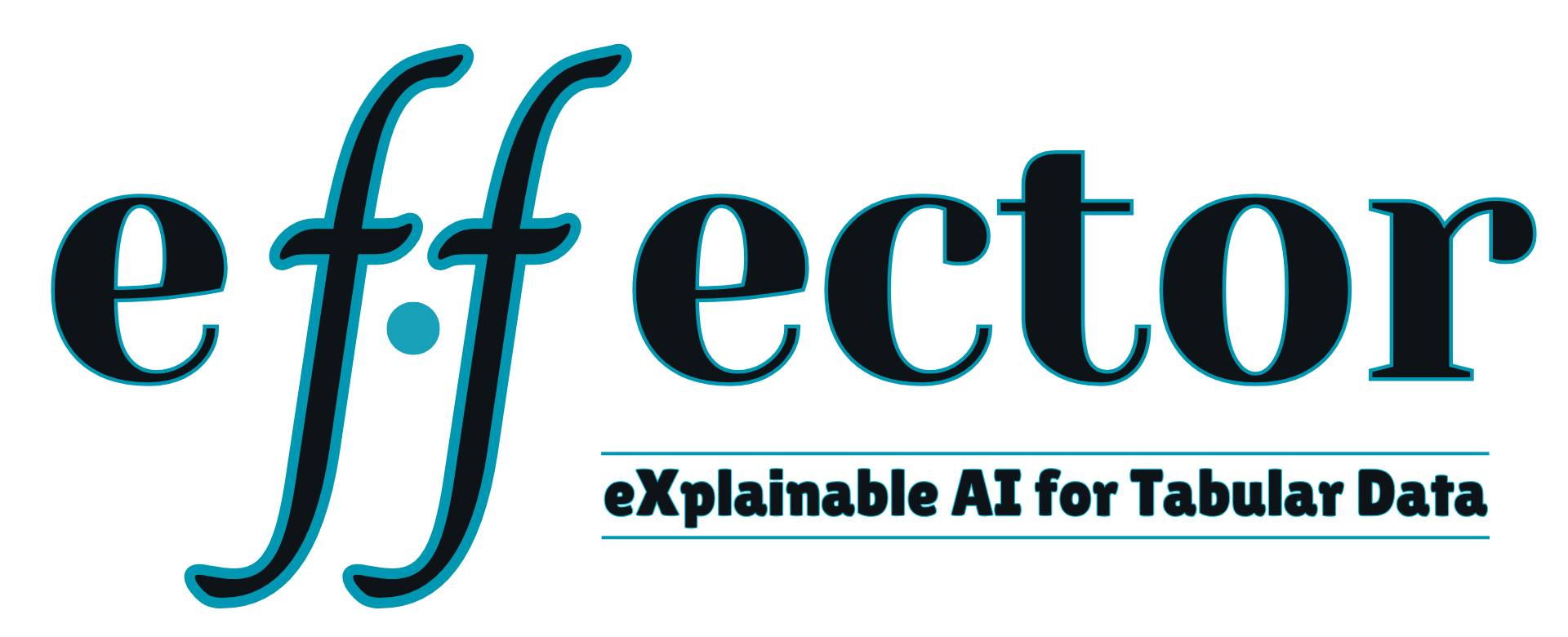
effector an eXplainable AI package for tabular data. It:
- creates global and regional effect plots
- has a simple API with smart defaults, but can become flexible if needed
- is model agnostic; can explain any underlying ML model
- integrates easily with popular ML libraries, like Scikit-Learn, Tensorflow and Pytorch
- is fast, for both global and regional methods
- provides a large collection of global and regional effects methods
📖 Documentation | 🔍 Intro to global and regional effects | 🔧 API | 🏗 Examples
Installation
Effector requires Python 3.10+:
pip install effector
Dependencies: numpy, scipy, matplotlib, tqdm, shap.
Quickstart
Train an ML model
import effector
import keras
import numpy as np
import tensorflow as tf
np.random.seed(42)
tf.random.set_seed(42)
# Load dataset
bike_sharing = effector.datasets.BikeSharing(pcg_train=0.8)
X_train, Y_train = bike_sharing.x_train, bike_sharing.y_train
X_test, Y_test = bike_sharing.x_test, bike_sharing.y_test
# Define and train a neural network
model = keras.Sequential([
keras.layers.Dense(1024, activation="relu"),
keras.layers.Dense(512, activation="relu"),
keras.layers.Dense(256, activation="relu"),
keras.layers.Dense(1)
])
model.compile(optimizer="adam", loss="mse", metrics=["mae", keras.metrics.RootMeanSquaredError()])
model.fit(X_train, Y_train, batch_size=512, epochs=20, verbose=1)
model.evaluate(X_test, Y_test, verbose=1)
Wrap it in a callable
def predict(x):
return model(x).numpy().squeeze()
Explain it with global effect plots
# Initialize the Partial Dependence Plot (PDP) object
pdp = effector.PDP(
X_test, # Use the test set as background data
predict, # Prediction function
feature_names=bike_sharing.feature_names, # (optional) Feature names
target_name=bike_sharing.target_name # (optional) Target variable name
)
# Plot the effect of a feature
pdp.plot(
feature=3, # Select the 3rd feature (feature: hour)
nof_ice=200, # (optional) Number of Individual Conditional Expectation (ICE) curves to plot
scale_x={"mean": bike_sharing.x_test_mu[3], "std": bike_sharing.x_test_std[3]}, # (optional) Scale x-axis
scale_y={"mean": bike_sharing.y_test_mu, "std": bike_sharing.y_test_std}, # (optional) Scale y-axis
centering=True, # (optional) Center PDP and ICE curves
show_avg_output=True, # (optional) Display the average prediction
y_limits=[-200, 1000] # (optional) Set y-axis limits
)
Explain it with regional effect plots
# Initialize the Regional Partial Dependence Plot (RegionalPDP)
r_pdp = effector.RegionalPDP(
X_test, # Test set data
predict, # Prediction function
feature_names=bike_sharing.feature_names, # Feature names
target_name=bike_sharing.target_name # Target variable name
)
# Summarize the subregions of the 3rd feature (temperature)
r_pdp.summary(
features=3, # Select the 3rd feature for the summary
scale_x_list=[ # scale each feature with mean and std
{"mean": bike_sharing.x_test_mu[i], "std": bike_sharing.x_test_std[i]}
for i in range(X_test.shape[1])
]
)
Feature 3 - Full partition tree:
🌳 Full Tree Structure:
───────────────────────
hr 🔹 [id: 0 | heter: 0.43 | inst: 3476 | w: 1.00]
workingday = 0.00 🔹 [id: 1 | heter: 0.36 | inst: 1129 | w: 0.32]
temp ≤ 6.50 🔹 [id: 3 | heter: 0.17 | inst: 568 | w: 0.16]
temp > 6.50 🔹 [id: 4 | heter: 0.21 | inst: 561 | w: 0.16]
workingday ≠ 0.00 🔹 [id: 2 | heter: 0.28 | inst: 2347 | w: 0.68]
temp ≤ 6.50 🔹 [id: 5 | heter: 0.19 | inst: 953 | w: 0.27]
temp > 6.50 🔹 [id: 6 | heter: 0.20 | inst: 1394 | w: 0.40]
--------------------------------------------------
Feature 3 - Statistics per tree level:
🌳 Tree Summary:
─────────────────
Level 0🔹heter: 0.43
Level 1🔹heter: 0.31 | 🔻0.12 (28.15%)
Level 2🔹heter: 0.19 | 🔻0.11 (37.10%)
The summary of feature hr (hour) says that its effect on the output is highly dependent on the value of features:
workingday, wheteher it is a workingday or nottemp, what is the temperature the specific hour
Let's see how the effect changes on these subregions!
Is it workingday or not?
# Plot regional effects after the first-level split (workingday vs non-workingday)
for node_idx in [1, 2]: # Iterate over the nodes of the first-level split
r_pdp.plot(
feature=3, # Feature 3 (temperature)
node_idx=node_idx, # Node index (1: workingday, 2: non-workingday)
nof_ice=200, # Number of ICE curves
scale_x_list=[ # Scale features by mean and std
{"mean": bike_sharing.x_test_mu[i], "std": bike_sharing.x_test_std[i]}
for i in range(X_test.shape[1])
],
scale_y={"mean": bike_sharing.y_test_mu, "std": bike_sharing.y_test_std}, # Scale the target
y_limits=[-200, 1000] # Set y-axis limits
)
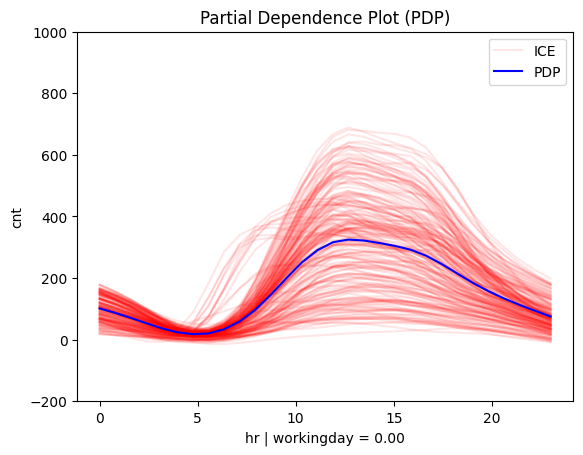 |
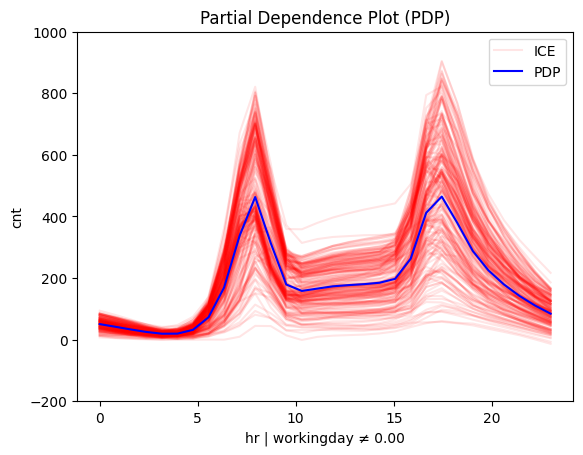 |
Is it hot or cold?
# Plot regional effects after second-level splits (workingday vs non-workingday and hot vs cold temperature)
for node_idx in [3, 4, 5, 6]: # Iterate over the nodes of the second-level splits
r_pdp.plot(
feature=3, # Feature 3 (temperature)
node_idx=node_idx, # Node index (hot/cold temperature and workingday/non-workingday)
nof_ice=200, # Number of ICE curves
scale_x_list=[ # Scale features by mean and std
{"mean": bike_sharing.x_test_mu[i], "std": bike_sharing.x_test_std[i]}
for i in range(X_test.shape[1])
],
scale_y={"mean": bike_sharing.y_test_mu, "std": bike_sharing.y_test_std}, # Scale target
y_limits=[-200, 1000] # Set y-axis limits
)
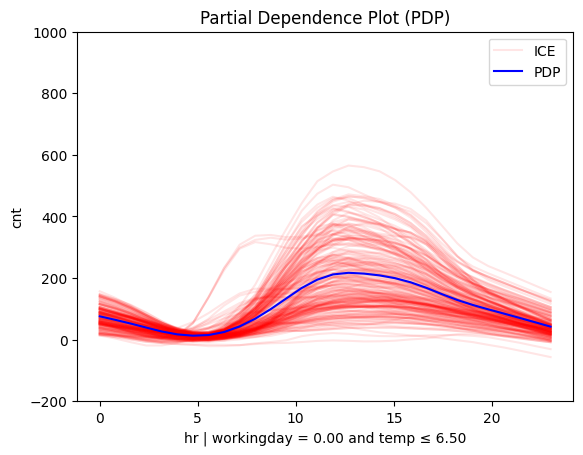 |
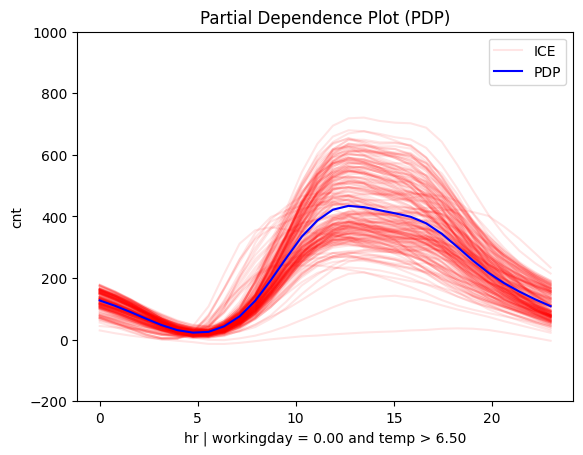 |
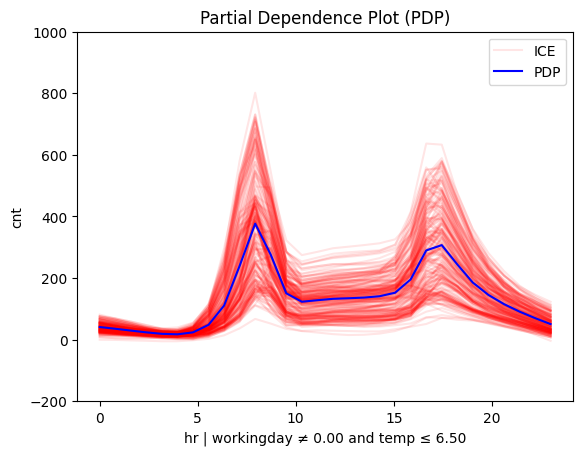 |
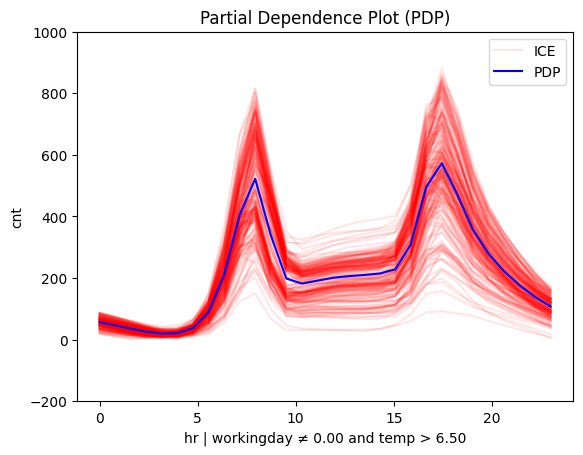 |
Supported Methods
effector implements global and regional effect methods:
| Method | Global Effect | Regional Effect | Reference | ML model | Speed |
|---|---|---|---|---|---|
| PDP | PDP |
RegionalPDP |
PDP | any | Fast for a small dataset |
| d-PDP | DerPDP |
RegionalDerPDP |
d-PDP | differentiable | Fast for a small dataset |
| ALE | ALE |
RegionalALE |
ALE | any | Fast |
| RHALE | RHALE |
RegionalRHALE |
RHALE | differentiable | Very fast |
| SHAP-DP | ShapDP |
RegionalShapDP |
SHAP | any | Fast for a small dataset and a light ML model |
Method Selection Guide
From the runtime persepective there are three criterias:
- is the dataset
small(N<10K) orlarge(N>10K instances) ? - is the ML model
light(runtime < 0.1s) orheavy(runtime > 0.1s) ? - is the ML model
differentiableornon-differentiable?
Trust us and follow this guide:
light+small+differentiable=any([PDP, RHALE, ShapDP, ALE, DerPDP])light+small+non-differentiable:[PDP, ALE, ShapDP]heavy+small+differentiable=any([PDP, RHALE, ALE, DerPDP])heavy+small+non differentiable=any([PDP, ALE])big+not differentiable=ALEbig+differentiable=RHALE
Citation
If you use effector, please cite it:
@misc{gkolemis2024effector,
title={effector: A Python package for regional explanations},
author={Vasilis Gkolemis et al.},
year={2024},
eprint={2404.02629},
archivePrefix={arXiv},
primaryClass={cs.LG}
}
Spotlight on effector
📚 Featured Publications
- Gkolemis, Vasilis, et al.
"Fast and Accurate Regional Effect Plots for Automated Tabular Data Analysis."
Proceedings of the VLDB Endowment | ISSN 2150-8097
🎤 Talks & Presentations
- LMU-IML Group Talk
Slides & Materials | LMU-IML Research - AIDAPT Plenary Meeting
Deep dive into effector - XAI World Conference 2024
Poster | Paper
🌍 Adoption & Collaborations
- AIDAPT Project
Leveragingeffectorfor explainable AI solutions.
🔍 Additional Resources
-
Medium Post
Effector: An eXplainability Library for Global and Regional Effects -
Courses & Lists:
IML Course @ LMU
Awesome ML Interpretability
Awesome XAI
Best of ML Python
📚 Related Publications
Papers that have inspired effector:
-
REPID: Regional Effects in Predictive Models
Herbinger et al., 2022 - Link -
Decomposing Global Feature Effects Based on Feature Interactions
Herbinger et al., 2023 - Link -
RHALE: Robust Heterogeneity-Aware Effects
Gkolemis Vasilis et al., 2023 - Link -
DALE: Decomposing Global Feature Effects
Gkolemis Vasilis et al., 2023 - Link -
Greedy Function Approximation: A Gradient Boosting Machine
Friedman, 2001 - Link -
Visualizing Predictor Effects in Black-Box Models
Apley, 2016 - Link -
SHAP: A Unified Approach to Model Interpretation
Lundberg & Lee, 2017 - Link -
Regionally Additive Models: Explainable-by-design models minimizing feature interactions
Gkolemis Vasilis et al., 2023 - Link
License
effector is released under the MIT License.
Powered by:
-
XMANAI
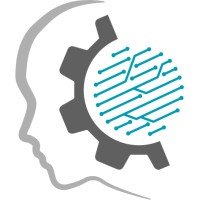
Project details
Release history Release notifications | RSS feed
Download files
Download the file for your platform. If you're not sure which to choose, learn more about installing packages.
Source Distribution
Built Distribution
File details
Details for the file effector-0.1.12.tar.gz.
File metadata
- Download URL: effector-0.1.12.tar.gz
- Upload date:
- Size: 55.0 kB
- Tags: Source
- Uploaded using Trusted Publishing? Yes
- Uploaded via: twine/6.1.0 CPython/3.12.9
File hashes
| Algorithm | Hash digest | |
|---|---|---|
| SHA256 |
ecdc5810bcd1bb5825fbe1e68e24838fd763dfe3f697be9b5158549124148e0f
|
|
| MD5 |
7fb0676733c05e857ec390c0f8a82b81
|
|
| BLAKE2b-256 |
6731e679519d4d003d5bc5684c370034e15857b9454934192a9f29b3c7c0b22c
|
Provenance
The following attestation bundles were made for effector-0.1.12.tar.gz:
Publisher:
publish_to_pypi.yml on givasile/effector
-
Statement:
-
Statement type:
https://in-toto.io/Statement/v1 -
Predicate type:
https://docs.pypi.org/attestations/publish/v1 -
Subject name:
effector-0.1.12.tar.gz -
Subject digest:
ecdc5810bcd1bb5825fbe1e68e24838fd763dfe3f697be9b5158549124148e0f - Sigstore transparency entry: 272799071
- Sigstore integration time:
-
Permalink:
givasile/effector@a80dd050f78dd3923bfdd03942abf196f588c8a7 -
Branch / Tag:
refs/tags/v0.1.12 - Owner: https://github.com/givasile
-
Access:
public
-
Token Issuer:
https://token.actions.githubusercontent.com -
Runner Environment:
github-hosted -
Publication workflow:
publish_to_pypi.yml@a80dd050f78dd3923bfdd03942abf196f588c8a7 -
Trigger Event:
push
-
Statement type:
File details
Details for the file effector-0.1.12-py3-none-any.whl.
File metadata
- Download URL: effector-0.1.12-py3-none-any.whl
- Upload date:
- Size: 63.6 kB
- Tags: Python 3
- Uploaded using Trusted Publishing? Yes
- Uploaded via: twine/6.1.0 CPython/3.12.9
File hashes
| Algorithm | Hash digest | |
|---|---|---|
| SHA256 |
51108fa8e42d28cde7c07dbe5e854380eb400697d3cd1b6fc601a32cfb0d5605
|
|
| MD5 |
f650d4db5c4c0db13eb597e2520f063a
|
|
| BLAKE2b-256 |
436cf52f8bf32757f9299f82234d244f2efa4f8628529e3f18c9a2fe05ee2302
|
Provenance
The following attestation bundles were made for effector-0.1.12-py3-none-any.whl:
Publisher:
publish_to_pypi.yml on givasile/effector
-
Statement:
-
Statement type:
https://in-toto.io/Statement/v1 -
Predicate type:
https://docs.pypi.org/attestations/publish/v1 -
Subject name:
effector-0.1.12-py3-none-any.whl -
Subject digest:
51108fa8e42d28cde7c07dbe5e854380eb400697d3cd1b6fc601a32cfb0d5605 - Sigstore transparency entry: 272799073
- Sigstore integration time:
-
Permalink:
givasile/effector@a80dd050f78dd3923bfdd03942abf196f588c8a7 -
Branch / Tag:
refs/tags/v0.1.12 - Owner: https://github.com/givasile
-
Access:
public
-
Token Issuer:
https://token.actions.githubusercontent.com -
Runner Environment:
github-hosted -
Publication workflow:
publish_to_pypi.yml@a80dd050f78dd3923bfdd03942abf196f588c8a7 -
Trigger Event:
push
-
Statement type:








